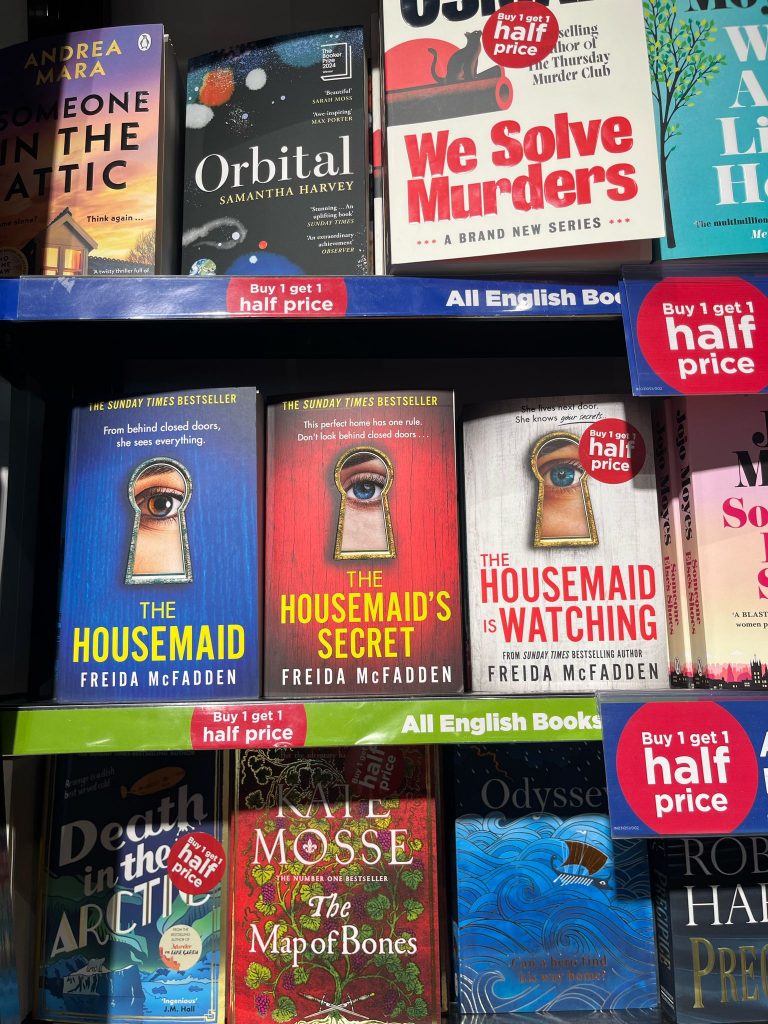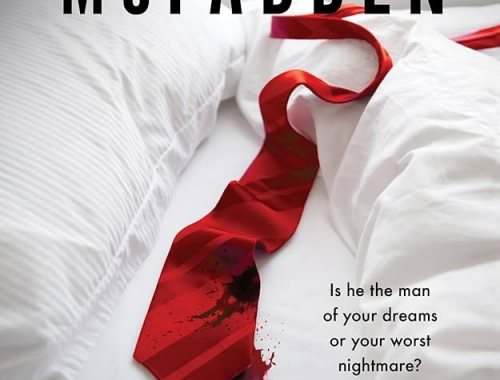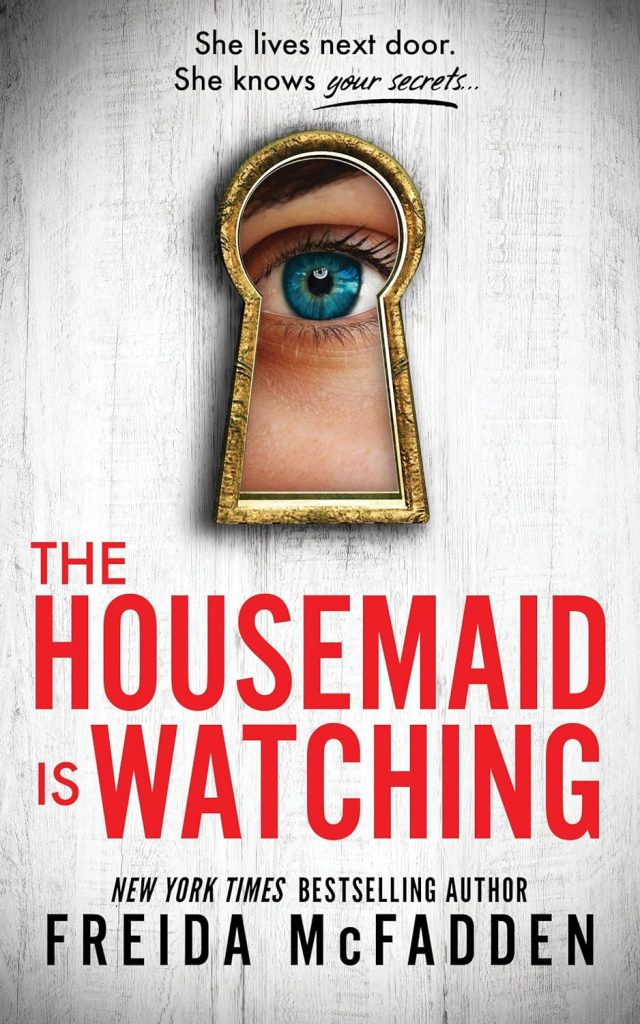
The Housemaid
Freida McFadden’s The Housemaid is a gripping psychological thriller that delves into themes of deception, power dynamics, and the haunting shadows of past secrets. The narrative follows Millie Calloway, a young woman with a troubled history, who secures a live-in housekeeping position with the affluent Winchester family. As she navigates her new role, Millie uncovers unsettling truths that challenge her perceptions and safety.
“Welcome to the family,” Nina Winchester says as I shake her elegant, manicured hand. I smile politely, gazing around the marble hallway. Working here is my last chance to start fresh. I can pretend to be whoever I like. But I’ll soon learn that the Winchesters’ secrets are far more dangerous than my own…
Every day I clean the Winchesters’ beautiful house top to bottom. I collect their daughter from school. And I cook a delicious meal for the whole family before heading up to eat alone in my tiny room on the top floor.
I try to ignore how Nina makes a mess just to watch me clean it up. How she tells strange lies about her own daughter. And how her husband Andrew seems more broken every day. But as I look into Andrew’s handsome brown eyes, so full of pain, it’s hard not to imagine what it would be like to live Nina’s life. The walk-in closet, the fancy car, the perfect husband.
I only try on one of Nina’s pristine white dresses once. Just to see what it’s like. But she soon finds out… and by the time I realize my attic bedroom door only locks from the outside, it’s far too late.
But I reassure myself: the Winchesters don’t know who I really am.
They don’t know what I’m capable of…

Read the series
Plot Summary
The Housemaid is a psychological thriller that uses alternating timelines and perspectives to reveal a dark truth hidden behind a seemingly perfect marriage.
The Setup and the Trap
Millie Calloway, a young woman with a criminal past, is hired as a live-in housekeeper for the wealthy Nina Winchester. Millie is unnerved by her tiny, attic room that locks from the outside, but she is drawn to Nina’s kind, appreciative husband, Andrew, and is desperate for the job. Nina, however, is high-strung and abusive towards Millie, creating huge messes and making accusations. Through gossip, Millie learns Nina has a history of mental health issues and once tried to harm her baby daughter, Cecelia.
Millie and Andrew begin an affair, which Andrew uses to manipulate Millie. He fires the landscaper, Enzo (who had warned Millie of danger), and orchestrates Nina’s exit. Andrew and Millie sleep together, and he promises them a future. Millie is then called by a blocked number, warning her away from Andrew, and she finds herself locked in the attic room—her phone missing.
The Truth Revealed (Nina’s Perspective)
A flashback reveals that Nina’s high-strung behavior was a facade designed to protect herself. Andrew is not a kind husband, but a sadistic abuser who locks her in the attic and tortures her for minor transgressions. He framed her for abusing Cecelia, landing her in a psychiatric hospital and ensuring her claims would never be believed. Nina’s erratic behavior was a deliberate attempt to drive Millie into Andrew’s arms, knowing that Millie’s criminal history made her capable of lethal violence and that Andrew would be attracted to her. Nina’s plan, which she kept secret from Enzo, was to hire Millie to kill Andrew.
The Climax and the Aftermath
Andrew returns to Millie, who is locked in the attic, and forces her to hold heavy books on her stomach as punishment. Millie uses a pepper spray bottle Nina had hidden for her, steals Andrew’s phone, and turns the tables, locking Andrew in the attic and torturing him similarly.
Enzo, worried by Millie’s silence, calls Nina back to the house. Nina, believing Millie is still trapped, unlocks the attic door and finds Andrew’s decomposing remains. Millie emerges, confessing to locking Andrew in for almost six days. Not wanting Millie to face a life sentence for a crime Nina orchestrated, she tells Millie to leave. The investigating detective, whose own daughter was once a victim of Andrew’s abuse, closes the case, ruling the death an accident. Andrew’s mother, Evelyn Winchester, reveals she disciplined Andrew with similar locking practices as a child, reinforcing the generational cycle of abuse.
The novel ends a year later with Nina and Cecelia moving to California. Millie, using money Nina sent her, interviews for a job at a new house. She recognizes the woman is being abused by her husband and assures her that she can help her, hinting at a new, similar plot to enact justice.
Fun Facts about the book.
Fun Facts About The Housemaid
Bestselling Success: The Housemaid has achieved significant acclaim, becoming a bestseller and solidifying McFadden’s reputation in the thriller genre.
Upcoming Film Adaptation: The novel is being adapted into a film starring Amanda Seyfried and Sydney Sweeney, bringing the suspenseful tale to the big screen.
Author’s Dual Career: Freida McFadden balances her writing with a medical career, specializing in brain injury medicine.
Drink Pairings
Enhance your reading experience with these thematic beverages:
Red Wine: A glass of deep red wine complements the novel’s rich and dark undertones.
Espresso Martini: This cocktail mirrors the book’s sharp twists and invigorating suspense.
Chamomile Tea: For a calming contrast, chamomile tea offers a soothing balance to the story’s tension.
Book Club Outfit Inspiration
Set the mood for your book club meeting with an ensemble that reflects the novel’s themes:
Classic Black Dress: Timeless and elegant, mirroring the story’s sophistication.
Statement Jewelry: Pieces that add intrigue, much like the plot’s unexpected turns.
Comfortable Flats: Practical yet stylish, suitable for an evening of deep discussion.
Character Analysis
Wilhelmina “Millie” Calloway
Millie is a central protagonist and one of the novel’s two narrators. A young, working-class woman with a criminal record, she is desperate for the stability of employment, which leads her to accept the job as a live-in housemaid for the wealthy Winchesters. Initially, she appears simple, hardworking, and naive, focused only on keeping her job and avoiding trouble.
However, the narrative quickly reveals a hidden, violent streak that is triggered only by unprovoked abuse or harm toward herself or others—a dark form of vigilante justice. She had previously retaliated with violence against a math teacher, an attempted rapist, and a harassing coworker. Millie’s survival mechanism is activated by Andrew’s cruelty, and she turns the tables on him with cold efficiency. She feels no remorse for her final actions, only concern over being caught, hinting at a pathological aspect to her violence. Millie acts as a foil to Nina, and her character arc sets up a potential sequel, suggesting she may continue her extreme form of protective justice.
Nina Winchester
is the novel’s other central character and second narrator, initially appearing as an affluent, volatile housewife. In reality, her erratic behavior is a deliberate, desperate performance to drive Millie into her husband Andrew’s path. Nina is the true victim of the story, trapped in an abusive marriage by a husband who tortures her and medically discredited her to ensure no one would believe her.
Nina’s actions are driven by her intense motherly instinct to protect her daughter, Cecelia. Unable to kill Andrew herself, she hires Millie, whose violent history makes her an ideal replacement. Nina and Millie are foils: Nina has superficial wealth but is imprisoned; Millie is poor but free. Ultimately, Nina demonstrates agency and a sense of responsibility by taking the fall for Millie’s actions, ensuring Millie’s freedom and Cecelia’s safety.
Andrew Winchester
is Nina’s husband, initially portrayed as a kind, henpecked man, but revealed to be the novel’s true villain and sadist. His character is a product of generational trauma and a quest for perfection, mirroring his abusive mother’s cruel “discipline.” As an adult, Andrew compulsively seeks out vulnerable women whom he can mold to resemble his mother, replicating her torturous punishments to reclaim a sense of power. He orchestrates Nina’s confinement and mental health diagnosis, viewing his abuse as justified “discipline.” His actions are entirely conflated with his twisted morality, and he feels no remorse.
Cecelia Winchester
is Nina’s nine-year-old daughter. Her rigid, peculiar behavior stems from being traumatized as an infant (nearly drowned by Andrew) and from the insecurity of her mother’s frequent disappearances. Though not directly abused, she is petrified of Andrew and feels intense pressure to be perfect around him. Her ultimate freedom and happiness, achieved after Andrew’s death, underscore the novel’s theme that escape from a toxic domestic sphere leads to healing.
Enzo
is the attractive, Sicilian landscaper who works for the Winchesters. His past is marked by tragedy: his sister died from her powerful husband’s abuse, a parallel he recognizes in Nina’s situation. Driven by empathy and attraction, Enzo is willing to risk his life to help Nina escape. He represents the “unseen” social stratum—those ignored by the wealthy hierarchy—who ultimately provide the means for Nina’s salvation, highlighting the irony in the novel’s theme of The Seen and the Unseen.

Symbols
The Room in the Attic
The attic room is an integral symbol that embodies the novel’s core theme of The Seen and the Unseen.
Symbol of Truth: The room’s sparse, isolated contrast with the mansion’s opulence mirrors the truth of the Winchester marriage: the beautiful facade hides Nina’s secret torture and confinement at Andrew’s hands. It is the place hidden from the eyes of the outside world.
Foreshadowing and Tension: The room immediately unsettles Millie because it locks from the outside, a detail that foreshadows both Nina’s imprisonment and Millie’s eventual fate. The sticking doorknob on Millie’s first night helps maintain the narrative’s tension and suspense.
Perspective of the Unseen: The room’s window looks onto the backyard, a space where only the “unseen” characters—the landscaper Enzo and the maid Millie (who are hired help from a lower social class)—can observe Nina’s hidden suffering, reinforcing the idea that those marginalized by the social hierarchy are the only ones privy to the truth.
White Dresses
White dresses are an important recurring symbol of Andrew’s demand for perfection and the irony of the women’s oppression.
Perfection and Transgression: White traditionally symbolizes purity and cleanliness, representing Andrew’s strict expectation of perfection from both Nina and Cecelia. The color’s stark nature means that the smallest imperfection or “blemish” becomes glaringly obvious, paralleling Andrew’s tendency to mete out harsh punishment for minor transgressions.
Uniform of Torture: Ironically, white becomes the uniform for the women Andrew tortures. His demand that they dress in pale clothing (and that Nina lighten her hair) is tied to his desire to mold his lovers in the image of his mother, Evelyn, who subjected him to similar “disciplinary” methods. The symbolism is further reinforced by the white clothing in the cardboard box of Andrew’s baby items sent by his mother, illustrating the generational cycle of abuse.
Millie’s Glasses
Millie’s glasses are a key element that highlights The Seen and the Unseen theme and the constant misdirection in the narrative.
Deliberate Deception: Millie wears the glasses to the interview to deliberately “dress down” her good looks and avoid intimidating Nina. This act of using an object designed for clarity to mislead or misdirect someone else ironically foreshadows the larger deceptions at play.
Inaccurate Perception: Despite Millie’s own attempt at deception, she is the one who is ultimately misled. Her “fake glasses” symbolize her inaccurate perception of the Winchesters: she believes Nina is the mentally unstable abuser and Andrew is the long-suffering victim, assumptions that are proven to be entirely false.
Bookclub Questions
What were your first impressions of Millie as a narrator? Did your perception of her change throughout the story?
How does Millie’s past influence her decisions throughout the novel?
Discuss the dynamics between Millie and the Winchester family. What power structures are evident?
What role does the setting play in building suspense?
How are themes of trust and betrayal portrayed?
In what ways does the novel challenge or reinforce societal perceptions of class and privilege?
How does the author use suspense and pacing to maintain tension in the book? Were there moments you had to stop and process?
Were there any red flags in the Winchesters’ behavior that stood out to you early on? How did your opinions evolve?
How do the power dynamics between employer and employee shape the events of the story?
What role does the house itself play as a character in the story? How did the setting influence your experience as a reader?
Do you think Millie made the right choices at key turning points in the book? Why or why not?
How does the author play with the theme of appearances versus reality? What scenes best illustrated this theme?
What do you think the book says about trust? Who can be trusted in this story—and who can’t?
How does The Housemaid compare to other psychological thrillers you’ve read? What made it stand out or fall short?
If you could ask Freida McFadden one question about the book, what would it be?
You May Also Like

The Boyfriend is Unbecredifabulous
October 26, 2025
How to read Mexican Gothic
May 11, 2023





